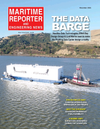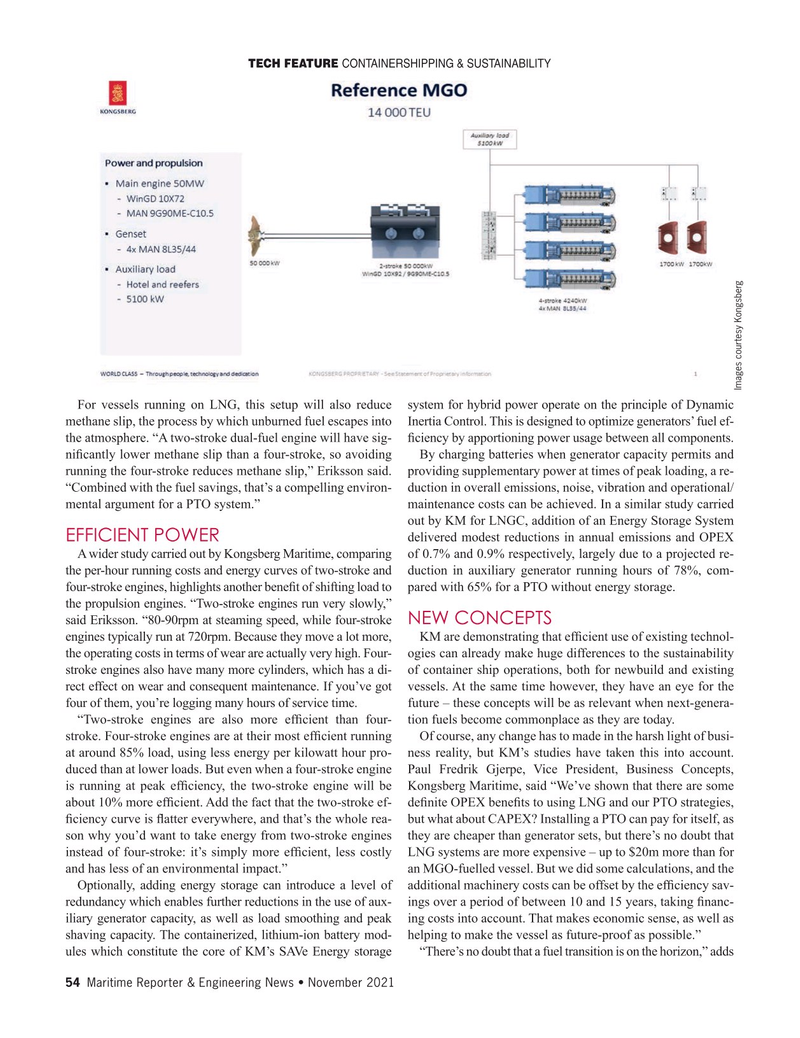
Page 54: of Maritime Reporter Magazine (November 2021)
The Workboat Edition
Read this page in Pdf, Flash or Html5 edition of November 2021 Maritime Reporter Magazine
TECH FEATURE CONTAINERSHIPPING & SUSTAINABILITY
Images courtesy Kongsberg
For vessels running on LNG, this setup will also reduce system for hybrid power operate on the principle of Dynamic methane slip, the process by which unburned fuel escapes into Inertia Control. This is designed to optimize generators’ fuel ef- the atmosphere. “A two-stroke dual-fuel engine will have sig- ? ciency by apportioning power usage between all components.
ni? cantly lower methane slip than a four-stroke, so avoiding By charging batteries when generator capacity permits and running the four-stroke reduces methane slip,” Eriksson said. providing supplementary power at times of peak loading, a re- “Combined with the fuel savings, that’s a compelling environ- duction in overall emissions, noise, vibration and operational/ mental argument for a PTO system.” maintenance costs can be achieved. In a similar study carried out by KM for LNGC, addition of an Energy Storage System
EFFICIENT POWER delivered modest reductions in annual emissions and OPEX
A wider study carried out by Kongsberg Maritime, comparing of 0.7% and 0.9% respectively, largely due to a projected re- the per-hour running costs and energy curves of two-stroke and duction in auxiliary generator running hours of 78%, com- four-stroke engines, highlights another bene? t of shifting load to pared with 65% for a PTO without energy storage.
the propulsion engines. “Two-stroke engines run very slowly,” said Eriksson. “80-90rpm at steaming speed, while four-stroke NEW CONCEPTS engines typically run at 720rpm. Because they move a lot more, KM are demonstrating that ef? cient use of existing technol- the operating costs in terms of wear are actually very high. Four- ogies can already make huge differences to the sustainability stroke engines also have many more cylinders, which has a di- of container ship operations, both for newbuild and existing rect effect on wear and consequent maintenance. If you’ve got vessels. At the same time however, they have an eye for the four of them, you’re logging many hours of service time. future – these concepts will be as relevant when next-genera- “Two-stroke engines are also more ef? cient than four- tion fuels become commonplace as they are today.
stroke. Four-stroke engines are at their most ef? cient running Of course, any change has to made in the harsh light of busi- at around 85% load, using less energy per kilowatt hour pro- ness reality, but KM’s studies have taken this into account. duced than at lower loads. But even when a four-stroke engine Paul Fredrik Gjerpe, Vice President, Business Concepts, is running at peak ef? ciency, the two-stroke engine will be Kongsberg Maritime, said “We’ve shown that there are some about 10% more ef? cient. Add the fact that the two-stroke ef- de? nite OPEX bene? ts to using LNG and our PTO strategies, ? ciency curve is ? atter everywhere, and that’s the whole rea- but what about CAPEX? Installing a PTO can pay for itself, as son why you’d want to take energy from two-stroke engines they are cheaper than generator sets, but there’s no doubt that instead of four-stroke: it’s simply more ef? cient, less costly LNG systems are more expensive – up to $20m more than for and has less of an environmental impact.” an MGO-fuelled vessel. But we did some calculations, and the
Optionally, adding energy storage can introduce a level of additional machinery costs can be offset by the ef? ciency sav- redundancy which enables further reductions in the use of aux- ings over a period of between 10 and 15 years, taking ? nanc- iliary generator capacity, as well as load smoothing and peak ing costs into account. That makes economic sense, as well as shaving capacity. The containerized, lithium-ion battery mod- helping to make the vessel as future-proof as possible.” ules which constitute the core of KM’s SAVe Energy storage “There’s no doubt that a fuel transition is on the horizon,” adds 54 Maritime Reporter & Engineering News • November 2021
MR #11 (50-65).indd 54 11/4/2021 11:08:29 AM

 53
53

 55
55
